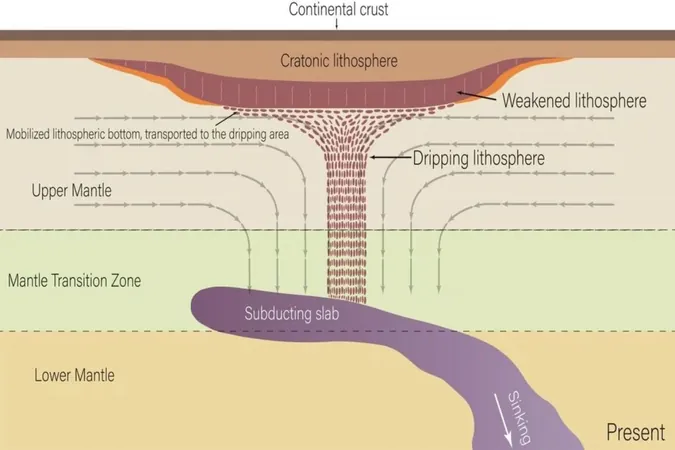
North America’s Secret Leak: What Scientists Just Uncovered Beneath Our Feet!
2025-04-14
Author: Ken Lee
A Stunning Discovery Beneath North America
In an astonishing revelation, scientists have uncovered a significant geological phenomenon beneath North America—rock formations are actually detaching, creating a real-time 'leak.' This groundbreaking finding by researchers at the University of Texas at Austin is the first instance of observing cratonic thinning as it happens, adding a riveting chapter to our understanding of continental evolution.
What’s Causing North America to 'Drip'?
This geological mystery revolves around several key factors: the ancient North American craton, the subducting Farallon Plate, the Earth’s mantle, and volatile compounds. Together, these elements are instigating a slow but continuous separation of the rock masses that form the backbone of the continent.
The North American craton, which spans large portions of the U.S. and Canada, typically remains stable for billions of years. However, like peeling paint from a wall, geological processes are gradually shedding rocks from this foundational layer due to the interactions with the Farallon Plate.
How This Incredible Geological Process Works
So, how do scientists explain this intriguing phenomenon? The process unfolds in a few key steps:
1. The Farallon Plate has been moving beneath North America for approximately 200 million years.
2. Even though it lies 600 kilometers away from the craton, the plate influences the flow of mantle material.
3. This interaction creates a shearing force against the craton's base.
4. Compounds released by the plate weaken the craton, precipitating the rock detachment.
5. This leads to the ‘leaking’ effect scientists have observed.
Revolutionary Detection Techniques
This groundbreaking discovery is part of a broader project led by Dr. Junlin Hua, using an advanced seismic tomographic model that represents the interactions between the craton and the mantle like never before. Professor Thorsten Becker explained that this modeling acts like an air purifier for geological formations, revealing processes that were previously invisible.
Modeling Groundbreaking Evidence
To validate their findings, researchers employed computer models simulating the relationship between the craton and the Farallon Plate. When they included the plate in their models, the dripping behavior appeared, and when it was removed, the dripping ceased—strong evidence reinforcing their hypothesis.
Historical Context and Unique Aspects
Interestingly, North America isn’t the first continent to experience this phenomenon—similar processes occurred in the North China craton millions of years ago. What sets this discovery apart is that it allows researchers to witness cratonic thinning in real-time.
Dr. Hua, now at the University of Science and Technology of China, noted that while the dripping is localized, the interactions have broader implications, suggesting a significant, albeit slow, geological transformation.
Should We Be Worried?
Residents of the Midwest, where the 'leak' is concentrated, may wonder if they should be concerned. Experts assure that there’s no need for immediate alarm. Unlike urgent household issues, this geological process occurs over extremely long timescales.
The visible impact on landscapes will take considerable time to manifest, and scientists believe that the separation will eventually stop as the remnants of the Farallon Plate sink deeper into the mantle, diminishing their influence on the craton.
Why This Matters for the Future
This remarkable discovery is a small part of Earth’s extensive narrative, shedding light on the dynamic processes that govern our planet over millions of years. Published in Nature Geoscience, it provides crucial insights for geoscientists eager to understand the ongoing evolution of continents—a complex recipe that is finally being studied in its mid-preparation phase.




 Brasil (PT)
Brasil (PT)
 Canada (EN)
Canada (EN)
 Chile (ES)
Chile (ES)
 Česko (CS)
Česko (CS)
 대한민국 (KO)
대한민국 (KO)
 España (ES)
España (ES)
 France (FR)
France (FR)
 Hong Kong (EN)
Hong Kong (EN)
 Italia (IT)
Italia (IT)
 日本 (JA)
日本 (JA)
 Magyarország (HU)
Magyarország (HU)
 Norge (NO)
Norge (NO)
 Polska (PL)
Polska (PL)
 Schweiz (DE)
Schweiz (DE)
 Singapore (EN)
Singapore (EN)
 Sverige (SV)
Sverige (SV)
 Suomi (FI)
Suomi (FI)
 Türkiye (TR)
Türkiye (TR)
 الإمارات العربية المتحدة (AR)
الإمارات العربية المتحدة (AR)